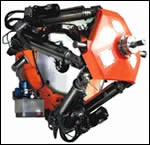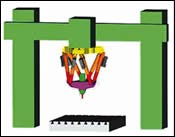Change Your Machine To A Hexapod
Want a hexapod machine but having trouble justifying the investment during these difficult times? Then you'll be interested in this hexapod attachment that converts most mills to a hexapod machine with a minimal investment.
Share







Autodesk, Inc.
Featured Content
View MoreShops considering the purchase of a hexapod machine may find it difficult to justify investing big bucks in machine tool technology that is relatively new to the marketplace. But now an attachment that converts conventional machining centers, boring mills, gantry mills and similar machines into hexapod machines is available. Some shops may find the attachment to be a more affordable way to enjoy the advantages of hexapod machines.
The hexapod attachment, made by CMW, a French company, mounts directly on the ram of a conventional machine tool. According to the company, the installation is no more complicated than replacing any standard milling head. Large machines with head-changers can easily include the hexapod attachment. Installation of the hexapod attachment is said to be so simple and fast that the attachment can be switched to other machines in the shop when need dictates.
The hexapod attachment consists essentially of six telescoping struts that are paired around a fixed plate at one end. They converge at the other end to support a moving plate that, in turn, supports a high speed machine spindle. The assembly looks something like a truncated cone (see photo at left).
Conventional machine tools rely on the simultaneous movement of large and heavy structural components of the machine (the column, head and so forth) to position the cutting tool at the correct location and orientation relative to the workpiece. The telescoping struts of the hexapod machine operate simultaneously to similarly locate and orient the spindle. Also, whereas the original design of a conventional machine tool limits its movement capabilities, the ability of the hexapod machine’s struts to permit virtually unlimited orientation of the spindle makes the hexapod suitable for three-, four- and five-axis machining.
For many applications, the hexapod attachment accounts for most of the movement: The host machine moves little, if at all. For example, where a machining operation is contained within the machining envelope of the attachment, the ram on which the attachment is mounted remains stationary while the attachment is working. If the area to be machined extends beyond the attachment’s envelope at a given location, the ram or column steps to a new position and stops, then the attachment resumes milling. However, for applications that call for extended machining in a given direction, the ram or machine column moves simultaneously with the attachment as needed.
Programming is described as being simple, and it requires no postprocessor. The operator can control the attachment with an electronic handwheel or joystick, program at the machine, or program the machine off-line using APT files from CAD or ISO files from a CAM package.
One interesting feature of the attachment is that it automatically corrects the positioning errors of the host machine. All errors in X, Y, Z and in roll, pitch and yaw are measured and entered in the machine’s software. The attachment then makes the necessary corrections.
The attachment is offered in two versions. The Hexapode CMW 300 has a 700-mm (27.6-inch) hemispherical working envelope and a 40 kW spindle capable of speeds up to 24,000 rpm. The Hexapode CMW 380 has a 1,050-mm (41.3-inch) hemispherical working envelope, and it can be equipped with an optional 70 kW spindle.
CMW, which manufactures special machines and tools for the French automotive industry, is currently seeking North American distributors for its hexapod attachment. Firms interested in obtaining more information about the attachment can e-mail the manufacturer at ugv@hexapode-cmw.com.
Read Next
5 Rules of Thumb for Buying CNC Machine Tools
Use these tips to carefully plan your machine tool purchases and to avoid regretting your decision later.
Read MoreBuilding Out a Foundation for Student Machinists
Autodesk and Haas have teamed up to produce an introductory course for students that covers the basics of CAD, CAM and CNC while providing them with a portfolio part.
Read MoreRegistration Now Open for the Precision Machining Technology Show (PMTS) 2025
The precision machining industry’s premier event returns to Cleveland, OH, April 1-3.
Read More











































.jpg;maxWidth=300;quality=90)




